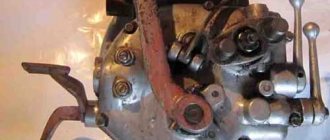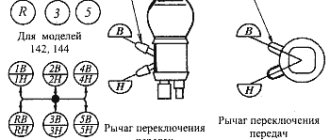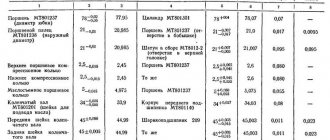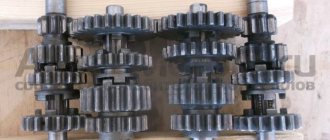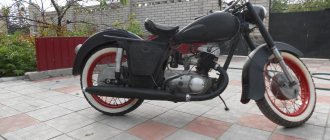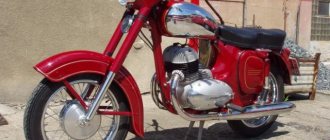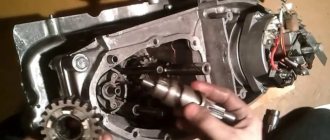Disassembly
For disassembly it is necessary to remove: — the clutch release rod with the release bearing parts; — starting lever; — a disk with two fingers of an elastic coupling of the cardan transmission from the secondary shaft; — right crankcase cover with manual speed control lever; - fork guide shaft; - shift forks; — unscrew the screws of the front cover; - after this, alternately hitting the primary and secondary shafts with a copper hammer; — remove the front cover with shafts and gears.
If necessary, disassemble the mechanisms: - disengaging the clutch; — foot switch; — manual switching; — gear shift forks; - launcher; - a cover with shafts and gears of constant mesh.
When disassembling the clutch release assembly, you should pay attention to whether there are any traces of crushing or twisting of the square end of the rod, whether the felt seal of the rod is damaged, whether the cylindrical end of the rod rotates freely and without jamming in the tip, whether the thrust bearing balls are falling out of the separator, whether the rubber ring (clutch slider seal).
Pay attention when disassembling the foot switch. For wear, crushing and breaking off the working edges of the pawls and the teeth of the selector sector. For jamming of the spring when compressed in the countersinks of the pawls. To loosen the return spring thrust screws, and also check whether the lever or the axis of the foot shift lever is bent and whether its finger is worn out, and whether the seals are in good condition.
When disassembling the manual speed control. It is necessary to make sure that there are no cracks in the place where the sector is welded to the roller and that there are no scuffs on the working surfaces, and also check whether the shift sector oil seal is in good condition and whether the shift lock ball is not stuck.
It is not recommended to disassemble the cover with rollers and constant-mesh gears unless clearly necessary, but you should only make sure that the gear teeth are in good condition, that the movable couplings are reliably engaged with the constant-mesh gears, that the movable couplings are easy to move and that the gearbox bearings are in good condition.
Return to contents — ↑
MY MOTORCYCLE
Today I want to talk about an unusual representative of the Irbit motorcycle industry. What could be unusual about it? We are all used to the fact that Urals have always been produced with sidecars and few people dreamed of a single model, but the motorcycle plant, I think, surprised everyone by starting the production of single vehicles.
Why suddenly? In the 90s, the demand for motorcycles with sidecars fell, and the Irbitsky plant decided to save the situation by releasing a single Ural “Solo” model, and then the oppositionists’ dream came true. After all, they tried to convert wheelchair users into singles and encountered more than one problem, but here everything is ready right away, you just need to complete it “for yourself” and ride. An inexpensive, reliable and powerful motorcycle with a low, straight handlebar and a classic riding position has become very popular among fans of city riding.
So, let's start with the motorcycle itself: the motorcycle is a bit surprising and pleases with a lot of chrome. There are many of them: fenders, mufflers, arches, wheel rims. In combination with the strict black color of the remaining parts, they give the car a solid and at the same time festive look. When it appeared, it immediately attracted the attention of not only ours, but also foreign fans of this style of motorcycle.
Actually, it was prepared for production with the expectation of the foreign market. Most of the plant's products are sold abroad (USA, England, France, and, more recently, China). But domestic fans were not forgotten; they also dropped a little, and “Solo” began to appear in our stores in scanty quantities. Most of the differences from the base model IMZ-8.103-10 concern the appearance. The Solo is equipped with two small mufflers (Nikonov exhaust system), gracefully raised at the rear and protecting the passenger’s legs from hot surfaces. Another thing that immediately catches your eye is the double mono-saddle and the side decorative plastic panels (the tool, as before, is stored in a drawer on the tank). Elements of passive safety include roll bars with reliable fastening to the frame and folding footrests for the driver and passenger. The front fender - it has become a little smaller - is attached to the fork stays and is unsprung.
Increasing the compression ratio to 8.5 due to spherical head pistons raised the engine power to 29.5 kW (40 hp) and requires the use of AI-93 gasoline. In new pistons, the piston pin axis is shifted 1 mm from its axis of symmetry - this reduces engine noise and cylinder wear. In addition, the “heart” of the motorcycle has become more “environmentally friendly” due to the use of a closed crankcase ventilation system. The gearbox has “lost” reverse gear - it is not needed for single driving. The Solo uses electronic non-contact ignition, which does not require adjustment during operation and ensures reliable engine starting even with a partially discharged battery. The reduction in the weight of the motorcycle and its total load capacity (225 and 175 kg, respectively) entailed a change in the suspension characteristics: the latter became softer. Leaving the hydraulic part of the shock absorbers unchanged, the developers lowered the stiffness of the springs by using wire with a diameter of 4 mm instead of 4.5 for the front and 7.5 mm instead of 8 for the rear.
The position of the lower support washers of the rear shock absorber springs has changed - they have dropped by 20 mm. Abandoning the sidecar and switching to 18-inch wheels required reducing the rear axle final drive ratio from 4.62 to 3.89. The Solo's maximum speed increased to 135 km/h, and fuel consumption was 5-7 l/100 km. The motorcycle can be equipped with a conveniently shaped fairing and plastic mudguards. The brake system remains the same drum type.
This was Solo at the beginning of its release, in the 90s. But I don’t finish the description here. I would like to show you now the modern model of this motorcycle. Of course, no major changes happened, but still…….
So, a more modern single Ural in our time:
Externally, it remains with a rich color and a good balance of painted and chromed parts. It looks good, as befits a classic motorcycle.
The tank is a “droplet”, its appearance is impressive, the lid on it is of a new design and is airtight. Now I would like to talk about the configuration: Irbitsk residents probably decided that they had made an eternal motorcycle, it would never break. Apparently they think so at the factory, since there is no space for tools. But - this, of course, is just terrible - but the tire pump is fixed in the most visible place. Although this is a small thing that can be eliminated.
The motorcycle has two options for completing seating positions: the basic model has a single seat, which is characterized by a rubber coating, or a double seat. In addition, there is the possibility of having two single seats. The price for the basic configuration of the Ural Solo motorcycle is about 215 thousand Russian rubles, which is considered a very competitive price compared to models from competing manufacturers.
The increase in cubes did not affect the power of the motorcycle in any way. The engine power is enough for dynamic acceleration. It feels like it’s not 40 l/s, but all 60.
The gearbox works, of course, well and clearly. But some shortcomings remained, for example, the long stroke of the lever. And most importantly, the fifth speed never appeared; as compensation there is a lever for quickly engaging neutral, as well as reverse gear (they returned it). On the Ural Solo-Classic, these options are not superfluous; even at a traffic light, it’s convenient to set the lever to neutral, and reverse gear helps when parking.
The two-cylinder engine runs on AI-92 gasoline. The motorcycle tank holds nineteen liters of gasoline.
The ignition system of this motorcycle is microprocessor-based, which ensures quick and easy starting of its engine. Fuel consumption per hundred kilometers in the urban cycle ranges from five to six liters. The cruising speed of the motorcycle is one hundred and five kilometers per hour, and the maximum permissible speed is one hundred and twenty kilometers per hour.
The Ural Solo motorcycle is available in different colors and, as mentioned above, in different configurations, so that each potential buyer can choose one or another version of the model of this motorcycle, depending on taste preferences and financial capabilities. In the end, we can say that the motorcycle is really not bad, there are a lot of good improvements. But..... I haven’t seen them in Ukraine yet - they are supplying them to foreign markets and for their consumers! Why is that?
Fault Inspection
When inspecting the parts, you should check the ease of movement of the forks along the rod. Condition of fork stays and ring grooves in movable couplings. The amount of axial movement of the forks in the groove of the engagement couplings.
The following malfunctions may occur in the trigger mechanism: - wear, crushing or chipping of the pawl; — jamming of the pawl pusher; — breakage of the pawl spring; — bending the ends of the return spring of the starting pedal; — damage to the working end of the buffer pin; — cracks in the starting lever; - wear of the oil seal.
Return to contents — ↑
Total information
Motorcycle type: with sidecar. Wheelbase, mm — 1430. Ground clearance, mm — 130. Track, mm — 1100
Dimensions, mm: — length — 2420; — width — 1650.
Height (by ignition key) - 1000
Motorcycle weight, kg: — dry — 335; - worker - 380.
Fuel consumption on the highway, l/100 km - 7. Fuel reserve on the highway, km - 310. Highest speed, km/h - 85.
Capacity (oil), l: - engine crankcase - 2.0; — gearbox housing — 0.8; — reverse gear housing — 0.150; — air purifier — 0.2.
Fuel tank capacity, l - 22.
Gearbox assembly
Reassembling the gearbox follows the reverse order of disassembly. First, the trigger shaft assembly with gear is installed into the hole in the rear wall of the crankcase. Then place the crankcase with the front hole up; after that, placing a paper gasket, insert the primary and secondary shafts assembled with a cover and bearings into it and press them into the rear wall of the crankcase with light blows of a hammer. Then the trigger shaft is put in place.
When installing the front bearing sleeve of the trigger shaft, it must be turned counterclockwise so that the spring is sufficiently wrapped and the starting pedal is sharply thrown back to its original position until it stops against the spring-loaded buffer rod.
After this, the parts of the gear shift forks, manual and foot shift, thrust bearing and rod are installed. After assembling the box, it is necessary to adjust the operation of the foot switch.
Similar articles:
- Adjusting the K-52 carburetor of the Ural motorcycle
- Carburetor repair
Return to contents — ↑
Repair and service
One of the main advantages of the gearbox on a Ural motorcycle is its high maintainability. Each owner can carry out a major overhaul of the gearbox in just a few days, provided that the necessary parts, spare parts, other consumables and tools are available.
To remove the unit from the motorcycle you need to do the following:
Typically, transmission repair involves replacing worn gears and adjusting the gear shift mechanism. Monitor the condition of the seals, since loss of lubricant will lead to unfavorable operating conditions of the unit, which will ultimately cause premature failure.
Engine
Engine type: four-stroke two-cylinder. Brand - M-72M. Cylinder diameter, mm - 78. Piston stroke, mm - 78. Working volume, cm³ - 746. Compression ratio - 5.5 ± 0.2. Maximum power, l. With. — 22. Maximum torque, kg m — 4.0. The block head material is aluminum alloy. The head gasket is asbestos metal 0.6 mm. The piston material is aluminum alloy.
Valve distribution phases (according to the angle of rotation of the crank), degrees: - beginning of intake to c. m.t. - 76; - end of intake after n. m.t. - 92; - beginning of release BC m.t. - 116; - end of release after c. m.t. - 52.
Carburetor - Two K-37.
Replacing the oil seal in the Urals
All work begins with loosening the front axle bolts located where the shock absorber is. Next, you will need to hang the vehicle, and then follow these steps:
The main difficulty of the procedure is that the feathers may not be pulled out from the places where they are attached. This can be solved by turning the nut in the opposite direction, as well as by lightly hitting it with a wooden object. If it doesn’t help the first time, you should do it again - the disassembly procedure will be much easier. After replacing the oil seal, boot and other elements that have become unusable, you can reassemble the motorcycle - all operations are carried out in the reverse order.
It is worth considering that when replacing oil seals/boots, you cannot use abrasive tools to clean adjacent elements, otherwise you will have to change not only the oil seals in the foreseeable future - the parts are treated with a special coating that protects against premature wear. Before installing the oil seal in its place, it will be necessary to process this element inside and outside, eliminating premature obsolescence.
Source
